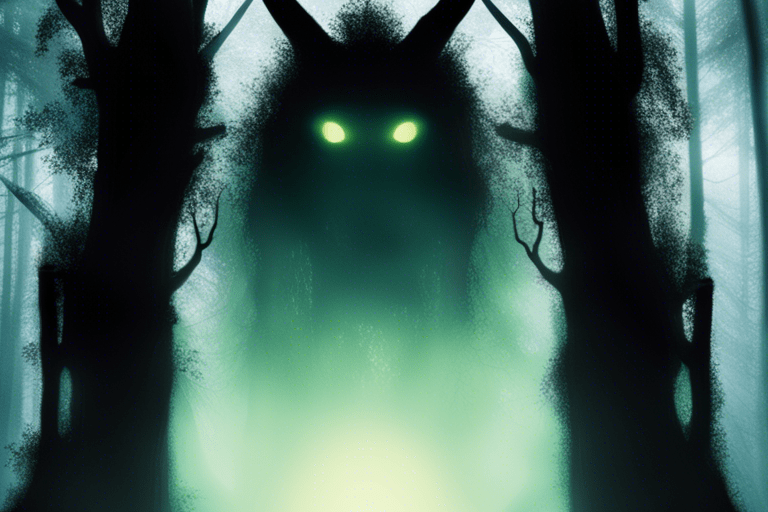Introduction
In the rich tapestry of Celtic folklore, few creatures captivate the imagination quite like the Púca. A mysterious and often misunderstood figure in Irish and Scottish traditions, the Púca is described as a shape-shifter that can take various forms. It might appear as a dark horse with gleaming eyes, a hare, or even a human with animal features. While some tales depict it as malevolent, others portray it as a trickster, or even a benevolent force. Traditionally associated with Samhain, the Celtic New Year, the Púca is deeply woven into the local folklore, embodying the wild and unpredictable spirit of the land.

The Púca’s significance extends across regions, with variations in appearance and behavior between the Irish and Scottish traditions. In Ireland, some farmers even leave a portion of their harvest as an offering to this enigmatic being. Scotland has its version known as the “Pooka,” each reflecting local cultural nuances, and though variations exist, the essence of the creature remains constant: a wild and unpredictable entity.
The name ‘Púca’ itself is derived from the Old Irish word ‘púc,’ which means ‘goblin’ or ‘sprite.’ This name encapsulates the creature’s mischievous and otherworldly characteristics. In different regions and languages, variations of this name appear, such as “Pooka” in Scotland or “Pwca” in Wales. The term has even found its way into modern English, with “puckish” denoting someone who is playfully mischievous. This linguistic legacy underscores the enduring impact of the Púca on contemporary culture.
Origins of the Púca Legend
The origins of the Púca myth can be traced back to a web of historical and cultural influences that have shaped the creature’s characteristics over time. Rooted in Celtic folklore, the Púca’s legend has mingled with various European mythological traditions, absorbing aspects of each and creating a composite that is rich and multifaceted.
Early descriptions of the Púca present it as a nocturnal creature, associated with the wild and often haunting crossroads and ancient landmarks. In some narratives, it is portrayed as an ominous figure capable of bringing good or bad fortune, depending on its whim. The Púca’s association with the harvest in Ireland and its connection to significant dates in the Celtic calendar hints at a deeper, agrarian significance.
Beliefs surrounding the Púca were likely influenced by a blend of pre-Christian pagan traditions and later Christian interpretations. The creature’s shape-shifting abilities and its association with the liminal spaces between the natural and supernatural worlds resonate with broader themes found in Celtic mythology, such as transformation, duality, and the connection between the physical and spiritual realms.
The Púca’s enduring appeal and continued presence in modern culture underscore its profound impact on the Celtic imagination. The origins of this mythical being reveal not only the rich and complex nature of Celtic folklore but also provide insight into the historical and cultural forces that have shaped these stories over centuries. The Púca’s legend is more than a mere tale; it is a window into the values, fears, and aspirations of a people intimately connected to their landscape and their past.
The Tale of the Púca
The tale of the Púca is one of intrigue and complexity, with various legends and stories painting a vivid picture of this enigmatic being. While the Púca can be found in both Irish and Scottish folklore, there are common threads that weave together the fabric of its myth.
Common Púca Legends and Stories
One of the most famous stories tells of the Púca appearing as a wild black horse with glowing yellow eyes, offering rides to those daring enough to mount it. Once on its back, the rider would be taken on a terrifying, uncontrollable ride, only to be dropped off unharmed at dawn.

In other tales, the Púca is known to spoil berries after Samhain, making them inedible, reflecting its association with the changing seasons. Farmers would leave offerings of crops to appease the Púca and ensure a bountiful harvest for the next year.
In some coastal areas, legends describe the Púca as a sea spirit, guiding lost fishermen back to shore, showcasing a more benevolent aspect of this multifaceted creature.
Appearance, Behaviors, and Supernatural Abilities
The appearance of the Púca varies widely, though common descriptions portray it as a dark, sleek animal with sharp features. Whether appearing as a horse, hare, or human with animal traits, its eyes are often depicted as glowing or shining, adding to its supernatural allure.

The behavior of the Púca is equally varied, ranging from mischievous and trickster-like to benevolent and guiding. Its unpredictable nature is a defining characteristic, making human interaction with the Púca a risky but often rewarding experience.
The supernatural abilities of the Púca are closely tied to its shape-shifting prowess. It is said to communicate with humans, often speaking in a human voice, and has been credited with prophetic abilities, foretelling events or guiding individuals towards their destiny.
Certainly! Here are the sections describing the Púca’s supposed appearance, behaviors, and supernatural abilities, along with an examination of its depiction in literature and art:
Description of its Supposed Appearance, Behaviors, and Supernatural Abilities
The Púca is a fascinating creature, known for its elusive and ever-changing appearance. It has been depicted as a dark, majestic horse, a mischievous hare, or even a human with animalistic traits. The common feature across these portrayals is its glowing eyes, which give the Púca an otherworldly presence.

Its behaviors are equally diverse and unpredictable. In some tales, the Púca is a playful trickster, while in others, it offers guidance and protection. Its supernatural abilities include shape-shifting, communication with humans through a human-like voice, and prophecy. This combination of appearance, behaviors, and supernatural abilities has made the Púca a multifaceted symbol, representing the unknown and mysterious in Celtic folklore.
Púca in Literature and Art
The Púca has found a lasting place in both ancient and modern Celtic literature and art. Its portrayal reflects the cultural richness of Ireland and Scotland and its deep connection to the natural and spiritual worlds.
Examination of the Depiction of Púca in Ancient and Modern Celtic Literature and Art
The Púca has been depicted in various forms of art and literature over the centuries. In ancient texts, it is often represented as a symbol of the untamed and mystical forces of nature. Sculptures and illustrations from medieval times capture the Púca’s wild and ethereal beauty.
Modern interpretations continue to explore the multifaceted nature of the Púca. Contemporary artists and writers draw inspiration from this ancient legend, adapting it to reflect current cultural narratives and challenges.
Discussion of Notable Appearances or References to the Púca in Classical and Contemporary Irish and Scottish Culture
The Púca has made notable appearances in classical literature, such as the Irish epic, “The Pursuit of Diarmuid and Gráinne,” where its enigmatic nature is explored.
In contemporary culture, the Púca has found its way into novels, movies, and even festivals. Authors like Yeats have referenced the Púca in their works, giving this mythical creature a modern context.

The Púca continues to be a subject of fascination, inspiration, and artistic expression, from traditional storytelling to avant-garde art installations. Its presence in literature and art is not merely a historical relic but a living symbol, continuously reimagined and reshaped, reflecting the evolving identity of Irish and Scottish culture.
Certainly! Here are the sections covering the variations of the Púca legend and its influence in popular culture:
Variations of the Púca Legend
The legend of the Púca is not a monolithic tale but a dynamic and evolving narrative that has taken on different forms and meanings across various regions of Ireland and Scotland. This section will explore these variations and compare the Púca with similar mythical beings in other Celtic cultures.
Exploration of Different Interpretations of the Púca Legend Across Various Regions of Ireland and Scotland
In Ireland, the Púca is often associated with the harvest and is known to spoil berries after Samhain. In some coastal regions, it takes on a more benevolent role, guiding lost fishermen home.
In Scotland, the Púca is known as the Pooka and has similar shape-shifting abilities but may be portrayed with different behaviors or characteristics, reflecting local beliefs and traditions.
Comparison Between the Púca and Similar Mythical Beings in Other Celtic Cultures
The Púca shares similarities with other mythical beings in Celtic cultures, such as the Pwca in Wales. These creatures often embody similar themes of transformation, duality, and connection with nature, though their specific traits and stories may vary.

The exploration of these variations enriches our understanding of the Púca and places it within a broader context of Celtic mythology, emphasizing the richness and diversity of these ancient narratives.
Púca in Popular Culture
The Púca is not confined to ancient tales but continues to thrive in modern media, including books, films, and TV shows. This section analyzes the influence of the Púca in popular culture and examines how contemporary portrayals have affected the traditional image of this mythical being.
Analysis of the Influence of the Púca in Modern Media Such as Books, Films, and TV Shows
The Púca has found its way into modern literature, with authors like Yeats referencing it in their works. Films and TV shows have also embraced the legend, using the Púca’s mysterious and unpredictable nature to craft compelling narratives.
Examination of How Contemporary Portrayals Have Affected the Traditional Image of the Púca
Contemporary portrayals of the Púca have both preserved and transformed the traditional image of this mythical creature. While some works strive to remain faithful to the original legends, others reimagine the Púca for modern audiences, exploring new themes or adapting its characteristics to fit contemporary contexts.
The influence of the Púca in popular culture attests to the enduring power and relevance of this ancient legend. Its adaptability and resonance with modern audiences ensure that the Púca continues to captivate and inspire, bridging the gap between the mythical past and our present reality.
Conclusion
The legend of the Púca is a remarkable testament to the depth and diversity of Celtic folklore. Its variations and manifestations across different regions of Ireland and Scotland, as well as its influence in literature, art, and popular culture, showcase its multifaceted nature and cultural significance. From ancient sculptures to contemporary novels, the Púca has transcended time and medium to remain a vital part of the Celtic imagination.
The Púca’s shape-shifting abilities, its unpredictable behaviors, and its connection to both the natural and supernatural worlds have contributed to its enduring allure and fascination. Whether viewed as a trickster, a guide, a harbinger, or a protector, the Púca resonates with universal themes that continue to captivate our collective psyche.
In the end, the Púca is more than a mere mythical creature; it is a symbol of transformation, a bridge between the known and the unknown, a reflection of our deepest fears and highest aspirations. Its legend is a rich tapestry woven with threads of history, culture, art, and human emotion, a tapestry that continues to unfold and reveal new dimensions.
The Púca reminds us of the power of storytelling, the mystery of nature, and the timeless appeal of the extraordinary. Its presence in our cultural consciousness is a tribute to the creativity and wisdom of those who first breathed life into this enigmatic figure, and a call to continue exploring the boundaries of our imagination and the endless possibilities of the world around us.






